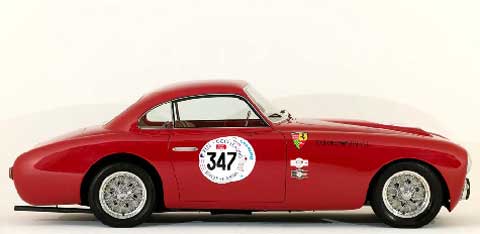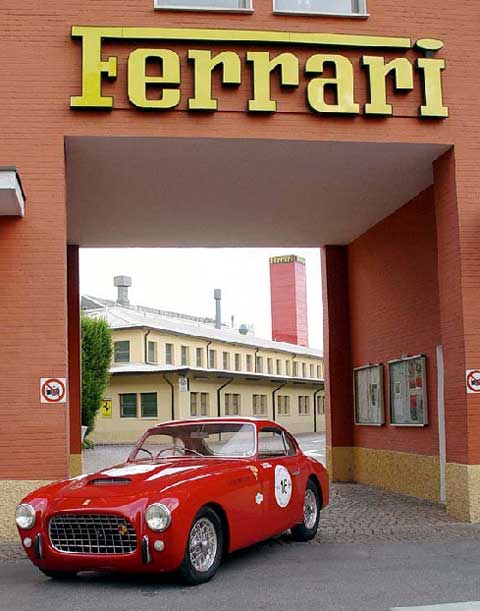 The Ghia Aigle, S/N 0137 E. Photo courtesy Warren de France.
The Ghia Aigle, S/N 0137 E. Photo courtesy Warren de France.
Last week in Larry Crane wrote of an early 195 Ferrari Ghia-Aigle, “It was a pretty, little car built by Ghia-Aigle in Switzerland,” he recalled.
We ran a photo of the Ferrari Ghia-Aigle, one I had found in the parking lot at the Monterey Historics in 2002. Both Larry and I thought it to be the same car, but a day or so later came an email from the current owner, Warren de France, along with a complete history and nice photos, some of which we are reprinting below.
But things didn’t match. The Ghia-Aigle at Monterey was a 212 Export, S/N 0137 EL, not a 195 as Larry remembered. Larry did a bit more research, and found first Allan Bishop, who worked on the 195, then historians Alan Boe and Warren de France to be helpful. Below, the second discription and history is of the real Larry Crane Ferrari Ghia-Aigle, S/N 0195 EL.
We start off with Warren de France’s excellent description of his Ghia Aigle, S/N 0137 E.
FERRARI 212 Ghia-Aigle S/N 0137 E By Warren de France
In the early fifties, it was typical for Ferrari to sell their product as a rolling chassis and leave the customer to choose a Carrozzeria to produce the body and interior. This varied the image of the 212 Ferraris, with several cars having distinct bodywork. Most 212s featured elegant Vignale or Touring designs with a few unique examples having Ghia-Aigle, Fontana, Stabilimenti, Motto or Abbott bodies. Motto and Fontana were less well-known, both firms designing and manufacturing bodies for the 212 Export’s.
The body of this strikingly beautiful 1951 Ferrari–S/N 0137 E was designed by Giovanni Michelotti as a freelance effort while still under contract to Sig. Alfredo Vignale of Carrozzeria Vignale fame. The official title of the car is a Ferrari Carrozzeria Ghia-Aigle. The Aigle label after the Ghia coach builders’ name refers to a Swiss based Carrozzeria.
In the late 1940s Mr. Philippi of Aigle, Switzerland, owner of an automobile repair shop, visited Carrozzeria Ghia in Torino. He asked to use the name Ghia for his own coach-building business. The men in Torino agreed, sold him a license and hence Philippi’s Ghia-Aigle coachworks were born. The French word Aigle means Eagle in English. In 1951 Ghia-Aigle bodied two, 212 Ferrari Exports, chassis numbers 0137 E and 0195 EL. The badge the Carrozzeria used was a brass plate with red, white and blue enamel, an eagle with wings spread and script Ghia-Aigle Lugano.
Michelotti’s drawings were transformed from pen and paper to coachwork by the respected Swiss firm of Carrozzeria Ghia-Aigle. The coachwork for #0137 is extremely unique and the only known example executed to this design.
The engine was designed by Gioacchino Colombo. It had a bore of 68mm by 58.8mm giving a displacement of 2562cc. Two, single overhead cam shafts, using a triple chain to drive the camshaft and rocker arms, finger followers and inclined valves make the engine design. The plugs sit on the inside of the engines vee. As was the practice at the time, the 212 series derived its type number from the total displacement of each cylinder in cubic centimeters..
The exterior of the car was also rather competition in nature and notably void of superfluous chrome or aluminum trim. No bumpers were initially fitted at the front or rear, giving the car an overall and strikingly racy appearance. Chassis 0137EL was numbered to depart the Ferrari factory as a Type or “Tipo†212 Inter, however the Carrozzeria, Ghia-Aigle designed and built this car as a Tipo 212 Export. The car’s ID plate, although stating it is an Export, does not always convince some. Several noted experts including, Mr. Marcel Massini, Bill Noon and writer Stanley Nowak (Ferrari on the Road) agree the car is a 212 Export. Cavallino magazine notes that #0137 has had some controversy over its correct designation, but stated in a previous issue “and it is a real 1951 212-Export Lungo Berlinetta with a rare body by Ghia-Aigle of Switzerland.â€
 0137 E. Photo courtesy Warren de France.
0137 E. Photo courtesy Warren de France.
The Ghia-Aigle factory issued a sales brochure for chassis number 0137 in 1951, (a copy of which the owner inherited), selling it as a Ferrari 212 Export by Ghia-Aigle. In early 1951, shortly after completion, the car was sold new to a Swiss resident, Mr. Thiebaud. The factory two piece windshield was updated early in the cars life to a single piece unit and bumpers were added front and rear.
Chassis number 0137 E was later exported to the United Kingdom and registered on U.K. plates “EAM 212L.†It was purchased (around 1975) and later offered for sale by the noted Ferrari enthusiast and connoisseur, Mr. Dan Margulies of London, England. The next custodian of this Ferrari was Mr. Buckland, who took the car to several shows and events. In 1985, 0137 E was exported from the U.K and imported into the United States. It was owned for several years by Mr. Robert Marceca and frequently seen at a variety of Ferrari Club Events throughout the 1980s and into the early 1990s. Mr. Mark McClintick, bought the car in 1992 and received a second in class for the National Concours in Grand Rapids the same year. In 1995, the car was sold by Symbolic Motor Car Company to Mr. Emile Yamano and imported into Japan. Mr. Yamano had the car carefully restored and prepared for vintage historic touring and racing events and has competed with the car in numerous venues over the years. Most notably, Mr. Yamano and his daughter raced the car in the Mille Miglia retrospective several times. In 1998 in was purchased by Yoshijuki Hayashi. The next year, 0137 E then became part of the growing Japanese Matsuda Museum Collection. The car was then sold to an American, Mr. Charles Arnott, who used the car regularly and entered it in the Mille Miglia and several other events, local and overseas. The custodian of this Ferrari changed in 2003, and was entered in the Mille Miglia retrospective again by Capt. W. de France, and invited to the Ferrari 60th in 2007.
Getting into the car is akin to getting into one of the super cars. Or have the modern cars reverted to the 1950s? The steering wheel is located virtually above the front of the driver’s seat. Instead of entering the car foot first, it is easier to enter head first and some how do a “triple lutzâ€, which will plonk you in the exact position for driving. Typically, it was built for the macho Italian of the fifties. The painted metal dash holds several necessary instruments, namely a rev counter (with water temperature and oil pressure gauge) and speedometer (fuel and clock). The pull switches for ancillary items are of a white ceramic material. They are laid out in a systematic pattern, but then, if one does not drive the car every week, knowing what operates what, is by experimentation at first. All the knobs are the same, but a couple of minutes in the car will log the few switches in your memory.
.
The gears are in a five speed pattern with first top left. Reverse requires you to push a button on top of the gear lever and locate the shift to the bottom right. Ferrari had a five speed box and a four speed box around the 1950’s.
First is of course non-synchronized, as is second, with third and fourth synchronized. Fifth gear is really an overdrive. Making second gear is difficult while the oil is cold so starting the days drive from first to third is a normal routine here. There is plenty of torque available to cope with missing second gear. Third to fourth is a regular change, maybe a double declutch. Not really necessary but it feels good. Back down the gears is pretty much the same, with third to second requiring a double declutch and being much easier than going up the gears. Back to first and you need to stop the car.
Driving around narrow and twisting roads, up and down the gearbox, is what this car was designed for. I believe I got more fun on this type of road in a 212, than if I was in a much more modern Ferrari.
There is immense pleasure derived from the difference this car is to a more modern car. This is particularly noticeable when going from first to second without leaving some of the gears behind (hypothetically speaking, of course). It is a story here of practice makes perfect. The car draws you into itself, and the whole day becomes very pleasurable. However, it is not a car you would drive every day. More concentration is needed to drive these old classics than driving a modern car at same relative speed. But then again, is this not what it is all about.
The owner is able to realize boyhood dreams, as this 212 is eligible for nearly every event conceivable including the Tour de France, Targa Florio, Mille Miglia, Colorado Grand, California Mille, Carrera Panamericana etc, etc. It certainly makes one think of all the possibilities that are available by owning such a car. Most would dearly like to do one of those events and I suppose all that has to be done for this lucky fellow is to make the time. The few cars that have survived this early period of manufacture are a tribute to Ferrari’s history. Every classic vintage Ferrari, seen today has some intriguing story associated with it.
[Below, Alan Boe’s description of the ex-Mark Dees Ferrari Ghia Aigle that Crane missed buying. Ed.]
FERRARI 195 Ghia-Aigle S/N 0195 EL By Alan Boe
    Ferrari 195 EL S/N 0195 EL is a steel bodied, RHD coupe. At the 1952 Geneva Show it was painted grey with a silver roof, then later repainted blue, then repainted yet again in red with a black roof. Eventually it became burgundy with a beige interior. It was finished in December 1951, has internal engine no. 125, and is built on a 2550 mm wheelbase chassis using a single Weber 36 DCF carb. It was sold new in March 1952 after the Geneva Show to Robert Bellorini of Lausanne, Switzerland. In 1955 it went to Italauto in Lausanne which was owned by noted race driver Baron de Graffenreid. It then went to Hans Wirz from Effretikon, Switzerland. Henry Morrow of Burbank, Calif., is the next owner, but I don’t know if he imported it. Then I have it with a C. A. Moore in Calif. before going to Mark Dees in Inglewood, Calif. on Dec. 30, 1969, in pieces. I show it had been badly crashed and was rusted and a poor rebuild had been attempted. Next it showed up for sale with Mike Sheehan in Costa Mesa in Dec. 1984 (he paid $22,500 for it and it was painted blue). He sold it to Ray Helm in Brisbane, Australia, still in pieces and then it went to David Rodd in Melbourne in Aug. 1996. That’s the last owner I have. It’s a neat car and is sometimes confused with S/N 0137 E, another Ghia- Aigle coupe but with a 212 motor.
So what was was the car that photographed at Laguna Seca in 2002 ? May be I am stupid, may be I am a dislexic, may be I suffer from ADD or may be I just do not master the language (English) sufficiently, or may be I am just too impatient …. but it is not clear to me from all the elaborate wordings in this present (2nd) article what the 2002 car at Seca actually is !
Perhaps one might read again the second and third paragraphs.
(Ed.)